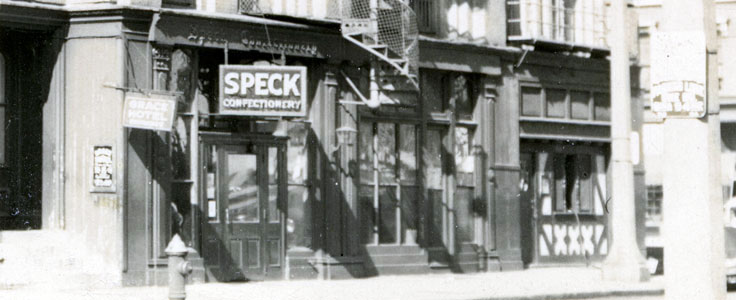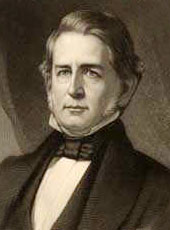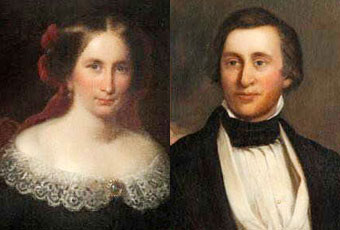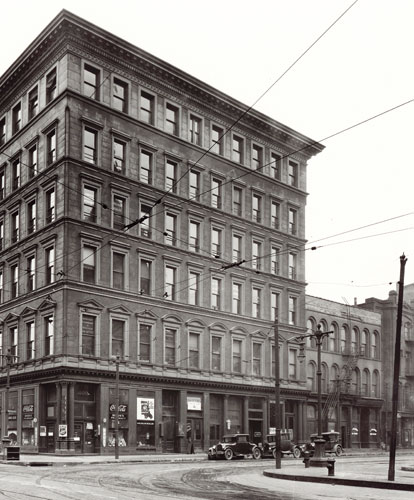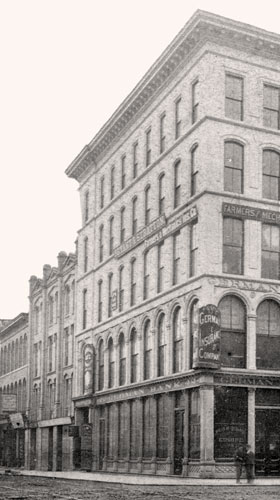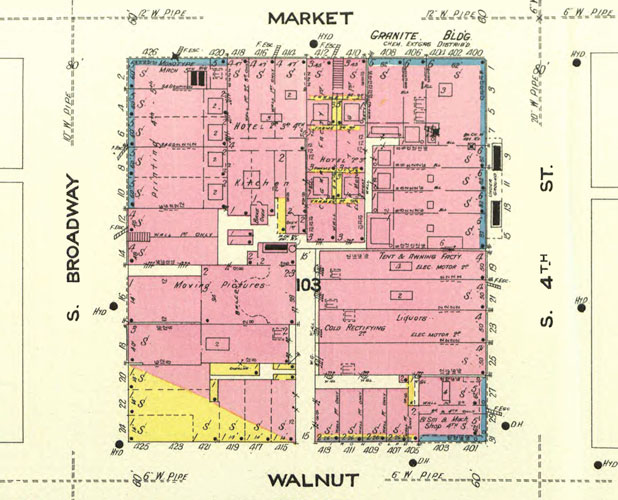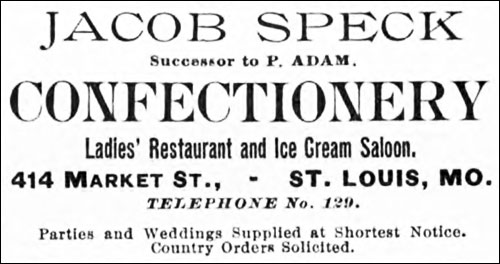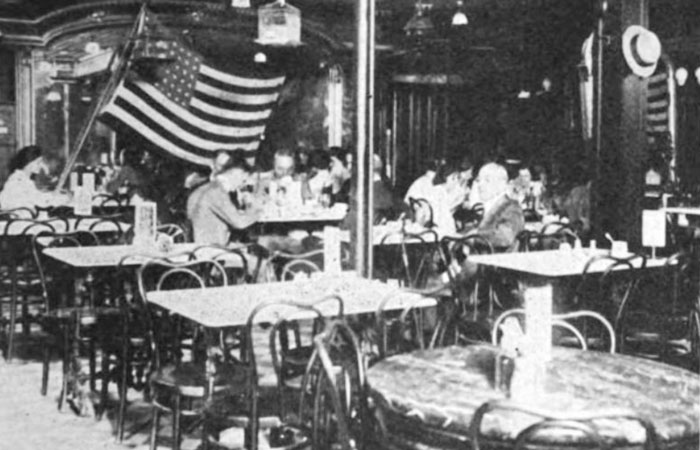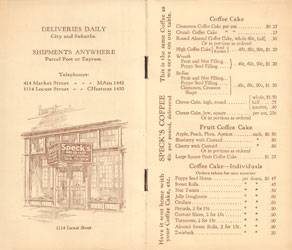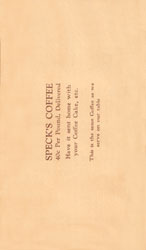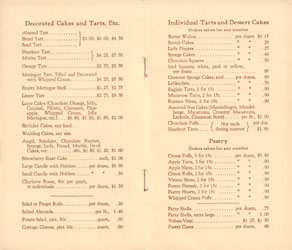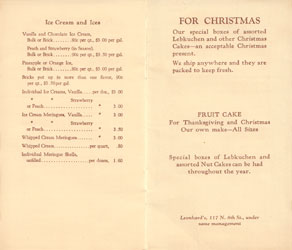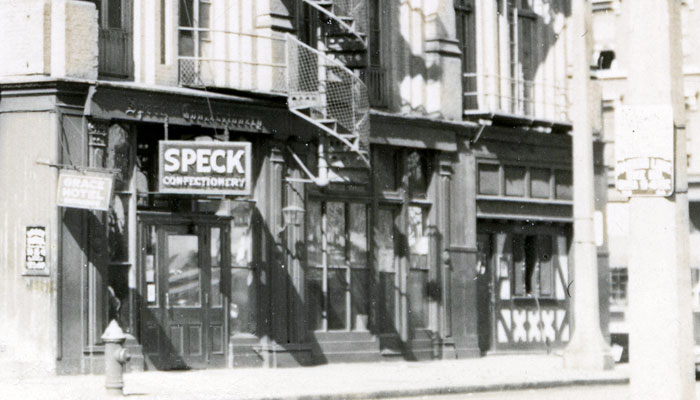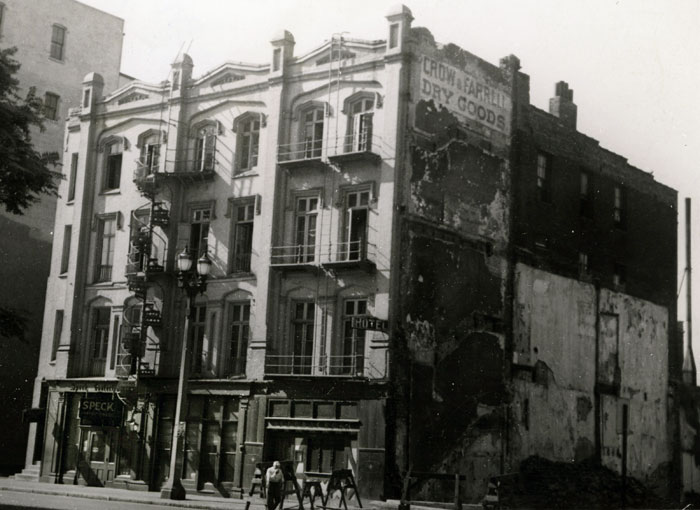|
Speck Confectionery
Early on, the village of St. Louis extended no farther west up from the Mississippi than Fourth Street. The top of the hill was a burial ground reserved for Indians and others not granted access to the churchyard. Auguste Chouteau, one of the city's founders, acquired title to the property in this area and donated a parcel of land to be "used forever as the site on which the courthouse of the County of St. Louis should be erected." In 1815, he gave notice he would not "suffer his land, adjoining the courthouse, in the town of St. Louis, to be used as a place of burial." He laid out "lots" on the property and sold the town's first real estate subdivision. On June 18, 1816, the western half of the city block bounded by Market on the north, Fifth Street (now Broadway) on the west and Walnut on the South was purchased by Joseph Charless, founder of the Missouri Gazette, the first newspaper west of the Mississippi. Charless built his residence, a two story brick building, at the northwest corner of the lot, with a large garden extending to Walnut. In 1822, the eastern half of Charless' lot was sold to his daughter, Ann. Upon Ann's death in 1832, the property was acquired by her daughter, Elizabeth. On June 10, 1848, Elizabeth and her husband, Taylor Blow, built a four-story building on the site, fronting Market, across the street from the courthouse. Taylor Blow died in 1869. The building he had constructed on Market Street was sold by his estate on the courthouse steps in 1875. The high bidder was Henry Shaw.
Shaw was a buyer of real estate, never a
seller. He held onto the property and subsequently willed it to the
Missouri Botanical Gardens, which he founded.
Taylor Blow's building at 414-416-418 Market
Street soon had neighbors. Wyman's Hall was built immediately to its
east in 1848. The six-story Granite
Building was constructed in 1874 on the corner of Market and Fourth.
And the German Bank was constructed to the west in the late 1860s on
the corner of Market and Broadway, at the site of the Joseph
Charless residence.
The first tenant in
Taylor Blow's building was the
Rutherford & Day dry goods store, occupying two large ground floor
rooms at 416-418 Market. In 1855, Nicholson's Family Grocery Store moved
into the same space, followed by Crow & Farrel Dry Goods. The
Lowenstein Hotel, Mielke's Hotel and Grace Hotel occupied the
upper floors in succession. The occupant of the ground floor space at 414 Market from 1848 to 1865 is detailed by William C. Eager in an October 10, 1932 article he wrote for the Minneapolis Tribune called "The Old Coffee House."
Eager describes a St. Louis coffee house established in 1848 by Jean Philippe Manck and Peter Gisler on Market Street, opposite the Old Courthouse. Manck had been a confectioner in Paris and seen military service under Napoleon Bonaparte. Later he became Burgomaster of a Bavarian town and a threatened revolution caused him to emigrate to St. Louis. Gisler was an early emigrant from Germany, who married Manck's daughter. Besides being a confectioner, he was a musician, playing the clarinet in a German musical society. Manck and Gisler's coffee house was a favorite of St. Louis' leading citizens. Among its regular patrons were Colonel George Knapp and his brother, John, then owners of the Missouri Republican, General John C. Fremont, General Frank P. Blair and representatives of the Chouteau, Benoist and other old French families. Gisler's son, August, became associated with the business as soon as he was old enough. Father and son manufactured the first chocolate cream cakes and introduced a machine for making lemon drops. They also put into operation the first soda fountain. The drink they dispensed from it was called New Orleans mead and was made from a recipe brought from France. * * * * * Paul Adam was the confectioner at 414 Market following Manck and Gisler. He was listed at that location in the St. Louis City Directory as early as 1872.
And by 1889, Jacob Speck took over the space.
Jacob Speck came to St. Louis from German in 1853 at the age of 12 with his brother and two sisters. He enlisted in the 4th cavalry during the Civil War, serving as a Union soldier throughout the conflict. By 1871, Speck worked as a confectioner at Leonhard's Confectionery at 320 Market. Conrad A. Leonhard founded his confectionery in 1844. Early on, it was more a coffee house, serving nothing but coffee and coffee cake. Leonhard did the baking and his wife made the coffee. In 1889, when Jacob Speck opened his own confectionery one block west at 414 Market, it was much like Leonard's, serving coffee and coffee cake. Both confectioneries gained city-wide reputations. Ironically, both owners died within months of each other, Speck at age 60 on December 14, 1901 and Leonhard at age 73 on March 27, 1902. * * * * * Hugo G. Goerner was born on July 27, 1858, in Springfield, Illinois and came to St. Louis with his parents before the outbreak of the Civil War. After working almost 25 years in the wallpaper business, he decided to become a restaurateur. In 1903, Goerner and his brother-in-law, C. Louis Hammerstein, purchased the Speck Confectionery at 414 Market from Jacob Speck's widow. A short time later, they bought Leonhard's Confectionary at 320 Market from Conrad Leonhard's estate. Goerner's eldest son Frank became a partner in the business when Hammerstein died in 1912. Eventually, all five of Goerner's sons were in the business.
The Goerners took care to preserve the
atmosphere at both Speck's and Leonhard's. The curiously carved and
curved old tables at which the patrons sipped coffee and the ancient
gilded full-length mirrors which cast back their reflections were
retained.
Business and professional men lunched regularly at both places. Until the Circuit Court moved from the Old Courthouse across the street in 1930, judges, lawyers and litigants were regular customers. Dominoes had been a popular pastime, but the gaming gradually died out, even in the upstairs smoking rooms. The Goerners had a policy of retaining old employees and employing "home girls" as waitresses.
Leonhard's original building at 320 Market street was razed in 1919 to make way for a fur warehouse and the Goerners moved the restaurant to 117 North Eighth. In August of 1930, the Goerners opened a second Speck's location at 1116 Locust. Speck's and Leonhard's clung to their "confectionery" class, although both were celebrated as restaurants. Their city-wide fame was derived from their coffee, which was served in heavy white china cups on antique tables of marble or hard woods. In the early days, the coffee was purchased green and roasted the day before it was served. Later, it was purchased roasted, the blend a secret of the Goerners and their trusted employees.
No liquor of any kind
was served and there was no demand for it due to the quality of the
coffee.
William Eager's 1932 Minneapolis Tribune article recounted Speck Confectionary in the early 1930s.
In 1945, the German Bank
building on the corner of Market and Broadway was torn down to make
way for a parking lot. Revealed on the uncovered brick wall was the
Crow & Farrel Dry Goods sign, an early occupant of the of the Taylor
Blow building, with Speck Confectionary still a tenant on the ground
floor.
The Speck's menu included a popular
potato salad, sold for 20 cents a side portion. For years cooks
throughout the area came up with their own versions of the Speck's
specialty, but something was always lacking. Finally, the recipe
appeared in a January 2, 1949 St. Louis Globe-Democrat
article. According to the article, "it took Thelma R. Leson, home
economist for an advertising agency, to spy out its secret."
In June of 1951, the Speck Confectionary at 1116 Locust was closed when its lease expired. In November of 1953, a fire swept through the Speck Confectionery at 414 Market, causing extensive damage. The restaurant did not reopen. The Goerners moved operations to their Leonhard's location at 117 North Eighth, changing the name to Speck. The historic Taylor Blow building at 414-416-418 Market was razed in June of 1954, the site used as a parking lot for Boatman's Bank. In early 1957, liabilities of over $67,000 threatened to close the remaining Speck location. A group of 29 St. Louisans, including Morton J. May, Sidney Schoenberg, Tom K. Smith, Senator Michael Kinney, Arthur Baer Sr. and Aloys P. Kaufmann put money into a reorganized company in an attempt to revive the historic restaurant. But continued losses and the need to replace outmoded equipment resulted in Speck Confectionery closing its doors on January 13, 1958.
Copyright © 2019
LostTables.com |
||||||||||||||||||||

